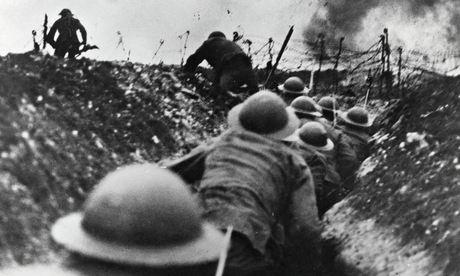
Are artists the canaries in the mine, warning of the coming explosion before anyone else? It's hard to look at the world before 1914 and not wonder if they somehow felt a catastrophe was bearing down on them and their societies. Henry James and Marcel Proust were challenging the old structures of plot in favour of exploring human psychology. The cubism of Braque or Picasso, the dissonant compositions of Schoenberg or Stravinsky, the free-flowing and often erotic choreography of Isadora Duncan and Nijinsky – these were acts of rebellion against the certainties and traditions of the old world. Did they somehow know they needed new ways of dealing with what was to come?
Fanciful perhaps, but artists may have antennae the rest of us lack. We too often think of those last years of peace as a golden age of prosperity and stability, of complacency even. Yet all was not well in Europe. European science, technology and industry produced a better life for millions but they also fuelled an arms race. Rapid change had brought its own tensions, from social strife to national rivalries. Pacifist impulses vied with militarism for the soul of Europe.
So often, in the literature of the time, we have the image of a thunderstorm about to break. Was revolution from below going to upturn the old order? Or were the powers going to send their massive armies and navies against each other? Intellectuals increasingly challenged the old comfortable assumption that human beings were rational – and that Europeans were more rational and more civilised than anyone else.
Artists reflected that unease. Some turned away, at least in part, from the modern world. Think of composers Vaughan Williams and Antonin Dvořák, who found inspiration in traditional folk songs. In Britain, there was a craze for history paintings, often of the Middle Ages. Other artists, though, faced forward into the 20th century. The Italian futurists, the German expressionists and the British vorticists were fascinated by speed and the ways the modern world was shattering conventions. The old ways of painting, writing, sculpting and composing no longer seemed adequate to capture the world. Modernism was born in part out of the need to find fresh ways of expression, to describe a new world that was unlike anything that had gone before.
And for some, war and violence were not things to be feared but welcomed, as ways of speeding up the destruction of the old and the outworn. War, said the Italian futurist Marinetti, "is the sole hygiene of the world". Rupert Brooke longed, he told his friends, for "some sort of upheaval".
It came in the summer of 1914. Europeans, contrary to later myths, did not greet the outbreak of war with wild enthusiasm. The cheering crowds were only part of the picture. People also marched through the streets to demand their governments uphold the peace. For most on the continent, the coming of a storm so long-anticipated was received with gloom, fear or sometimes with despair about European civilisation.
Yet each also felt their nation was the innocent one, that their war was merely defensive. In this, artists were in tune with their own societies. Many were swept up in the burst of patriotism in the war's early stages – and volunteered. In those four long years, Europe was to lose over 9 million men, among them what could have been leaders, scientists, thinkers – and of course artists. German expressionist Franz Marc, French sculptor Henri Gaudier-Brzeska and the British poet Wilfred Owen – all died on the western front.
Of those artists who survived, some fell silent, unable to deal with the enormity of the war. Others such as John Nash tried to grapple with it and found that the avant-garde of the last years of peace had given them the tools they needed. The broken battlefields, with their torn earth and their trees at crazy angles, looked like cubist paintings; while the bursts of shells in the night skies, the figures stumbling across no man's land or the creeping clouds of greenish poison gas echoed symbolist paintings, with their mystical landscapes and colours full of meaning. Ford Madox Ford's great quartet about the war, Parade's End, is like Proust in its exploration of the workings of the heart and the conscious and unconscious mind.
We have the statistics from the Great War: so many killed and so many wounded, the lists of battles, the towns and cities destroyed, the countryside poisoned and flooded, the resources expended. But they are too big to comprehend. And how do we make sense of the four years of fighting, the imperfect peace and the dreadful legacies left for the 20th century. Historians can tell part of the story. But what did the war mean for those who were part of it? And what did it mean for European civilisation? We need artists to help us answer those questions.
Margaret MacMillan, a professor of international history at Oxford University, was the first woman to win the Samuel Johnson prize, for Paris 1919: Six Months that Changed the World (2001). Her most recent book is The War that Ended Peace.

